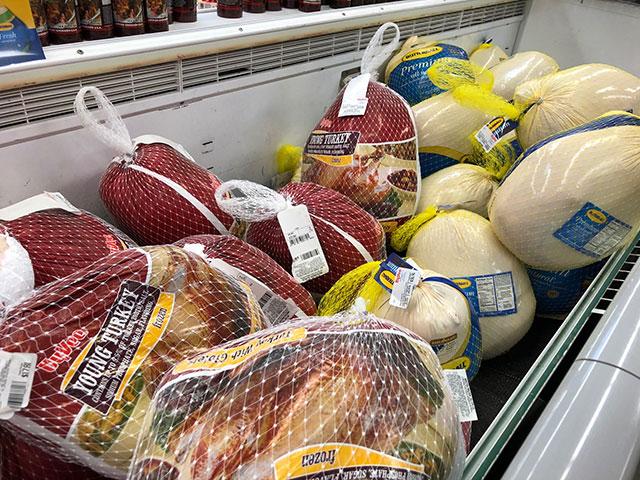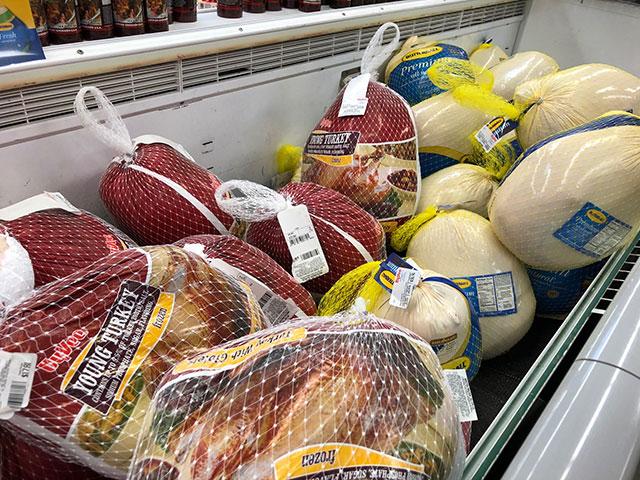Ag Policy Blog
Thanksgiving Costs Fall, but Farmers Still See Pennies for the Bounty
The average cost of a "classic" Thanksgiving dinner is about 5% cheaper than last year -- unless your family meal also includes a ham, russet potatoes and frozen green beans, which all saw price increases.
The American Farm Bureau Federation's 40th annual Thanksgiving dinner survey shows the average cost of a 10-serving classic holiday meal is $55.18, a $2.90 decline from 2024. If you go big with the added ham, russet potatoes and green beans, the meal cost rises to $77.09, just 28 cents cheaper than 2024.
Meanwhile, the National Farmers Union also released its annual Thanksgiving Edition of the "Farmer's Share of the Food Dollar." Farmers continue to receive only pennies on the dollar for foods typically consumed for Thanksgiving dinner despite higher overall grocery prices.
The farmer's share of every dollar spent on food remains roughly 16 cents, according to the latest U.S. Department of Agriculture data.
So. out of that $55.18 meal for 10 people, farmers who grew that food collectively split about $8.83.
"Even in a season of gratitude, we must acknowledge the continuous inequality in our food system and agriculture industry," said NFU President Rob Larew. "Family farmers and ranchers work year-round for historically low profits across all sectors of the industry, while consumers are still paying unsustainably high prices at grocery stores. Fairness for farmers is also fairness for consumers -- when rural America does well, we all benefit."
Prices of several of the items reflect some of the struggles of farm and ranch families working to stock the grocery store shelves, AFBF noted.
High labor costs and worker shortages are a major driver of produce costs. Fruits and vegetables rely heavily on manual labor for planting, harvesting, grading and packing, with labor expenses making up nearly half of total production expenses for these industries. Persistent labor shortages and higher wage requirements have increased production expenses for growers, and these higher on-farm costs eventually factor into grocery store prices, AFBF stated.
This year's survey reflects an even split with half of the surveyed items decreasing in price while half increased. The drop in frozen turkey prices was the primary factor in the overall savings, aided by retailers offering holiday deals to attract shoppers.
Over the span of the AFBF Thanksgiving survey, turkey has accounted for an average of 43% of the total dinner cost. However, this year, a 16-pound turkey only accounts for 39% of the cost of a 10-person Thanksgiving dinner. This is turkey's lowest share since 2000.
The price of Thanksgiving dinner peaked in 2022 at about $64.05. A lot of that higher cost at that time was driven by the higher cost of turkeys that year, due in part to avian influenza.
For this year's AFBF survey, items that decreased in price include:
P[L1] D[0x0] M[300x250] OOP[F] ADUNIT[] T[]
-- A 16-pound frozen turkey: $21.50, or $1.34 per pound (down 16.3%).
-- A 12-ounce bag of fresh cranberries: $2.28 (down 2.8%).
-- One dozen dinner rolls: $3.56 (down 14.6%), 14 ounces of cubed stuffing mix: $3.71 (down 9%) two frozen pie crusts: $3.37 (down 0.8%), all due to lower wheat prices.
-- Miscellaneous ingredients needed to prepare the meal: $3.61 (down 4.7%).
Items that increased in price include:
-- Three pounds of sweet potatoes: $4 (up 37%), largely due to hurricane damage in North Carolina, the nation's top producer.
-- A 1-pound veggie tray consisting of carrots and celery: $1.36 (up 61.3%), reflecting the volatility of fresh produce pricing driven by weather, transportation delays and other supply-chain factors.
-- One pound of frozen peas: $2.03 (up 17.2%).
-- One gallon of whole milk: $3.73 (up 16.3%) and a half pint of whipping cream is $1.87 (up 3.2%).
-- A 30-ounce can of pumpkin pie mix: $4.16 (up 0.1%).
It's important to note that fresh vegetables and potatoes are traditionally low-cost items, meaning even small increases can lead to high year-over-year percentage changes.
NFU pointed out a farmer receives only 6 cents a pound for that turkey. So, a 16-pound turkey generates 96 cents for a farmer.
For a two-pound boneless ham that could cost consumers $12.98, the pork producer receives $1.58.
NFU's Fairness for Farmers campaign continues to spotlight how consolidation and anti-competitive practices in the food and agriculture supply chain squeeze both ends of the system. By pushing for stronger antitrust enforcement, transparency, and fair markets, the campaign aims to ensure farmers receive a more equitable share of the food dollar, and that consumers see relief at the checkout line.
"Every Thanksgiving, the numbers tell the same story: farmers aren't asking for a bigger slice of pie, just a fair one," Larew added. "It's long past time to fix a food system that works for corporations but not for the families who grow and consume our food."
Other surveys also are showing some difference in prices due in part to particular items.
Purdue University, for instance, stated in a survey at the end of October, "This year's Thanksgiving centerpiece comes with a particularly hefty price increase. Wholesale turkey prices have surged 75% since October 2024, reaching $1.71 per pound in October 2025." Purdue added, "Our model predicts an average retail price of approximately $2.05 per pound in November."
Walmart came out with its survey on Oct. 21 stating its meal using more than 20 national and private brand items came in at its lowest price since 2019, serving 10 people for less than $40. That included a 13.5-pound Butterball turkey at 97 cents a pound.
For more on costs, see:
-- https://corporate.walmart.com/…
Chris Clayton can be reached at Chris.Clayton@dtn.com
Follow him on social platform X @ChrisClaytonDTN
(c) Copyright 2025 DTN, LLC. All rights reserved.






Comments
To comment, please Log In or Join our Community .